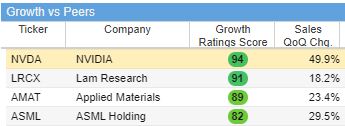Nvidia’s RTX 30 Launch Is a Positive Game-Changer
NVDA stock will benefit from the refresh of the GeForce with the RTX 30 product release
Although it is cliché to call a major product release a game-changer, Nvidia’s (NASDAQ:NVDA) RTX 30 Ampere is just that. The architectural refresh solidifies the company’s dominance in the graphics card (GPU) space. Advanced Micro Devices (NASDAQ:AMD) cannot afford to ignore its competition. AMD’s Navi is falling further behind. Investors should ask how might RTX 30 benefit NVDA stock.
Nvidia announced its “greatest-ever generational leap” with the GeForce RTX 30 series. On paper, the second-generation RTX card looks good. It has double the performance over the current Turing cards. Consumers may further enjoy artificial intelligence gaming and real-time gaming.
Price and Sales
Hard-core gamers are typically not price-sensitive to product pricing. Nvidia is asking for $699 for the GeForce RTX 3080 model. This has 10GB of GDDR6X memory and supports 4K resolution gaming. If sales soar, chip suppliers like Micron Technology (NASDAQ:MU) should also benefit. In August, Micron signaled modest weakness in the current quarter in DRAM and NAND sales. Micron’s customers over-estimated chip demand and ordered too much.
Nvidia’s product refresh may help offset that excess supply.
At the top end, the GeForce RTX 3090 is priced at $1,499. It is so powerful that Nvidia named the GPU as a BFGPU – Big Ferocious GPU. The product offers performance that is up to 50% faster than its existing Titan RTX card. Gamers may play the top games at 60 frames per second in 8K resolution.
Hype is Real
Before the GPU unveiling, Nvidia stock topped $589.07. It ended the week at $504.90. The drop is due mostly to profit-taking in the technology sector in general. If markets grow wary of semiconductor stock valuations, then Nvidia shares could break an uptrend that began from the V-shaped March recovery.
Fundamentally, Nvidia’s 3090 BFGPU hype is real. The GPU is the first mainstream 8K gaming solution on the market. The lower-tier cards will target the mainstream and budget customer. So, the product mix will assert Nvidia’s dominance in the GPU market. AMD will have to come up with a comparable product just to avoid losing more market share in the coming quarters. In the near-term, AMD might have to cut prices, which only helps Nvidia as it unloads inventory in the previous-generation GPU.
Current gamers using the 1080Ti, released in 2017, may feel safe now in upgrading. Nvidia introduced a direct bypass between GPU memory and storage. This will keep GPUs busy and circumvent the bottleneck caused by a slow input-output (I/O).
Valuation of NVDA Stock
On Wall Street, analysts are bullish on NVDA stock, with most ratings a “strong buy.”

Contrarian investors may look at the excess optimism as a bearish sign. If Nvidia stock is too mainstream a technology pick, then the upside is limited.
Compared to its peers, Nvidia scores well on growth.

As shown above, the quarterly sales rate determines the growth score. Quarter-over-quarter growth is double that of comparable technology firms.
Endless Opportunities
Ray tracing (RTX) is leading the gaming market in re-defining graphics. Executive Vice President Colette Kress noted that GeForce is the top gaming platform. So, as the company launches its new Ampere architecture, expect sales from the gaming division to beat market expectations.
On the data center space, the related Ampere architecture in its A100 benefited from strong demand. Nvidia is still in the early phases of the A100 ramp.
Following the close of its Mellanox acquisition, the company will benefit from the cloud scale-out of its AI services. For example, A100 DGX and DGX SuperPOD are two products that will lift its enterprise sales.
Nvidia shares look expensive but for a good reason. Management continues to execute very well and is consistently beating expectations.
On the date of publication, Chris Lau did not have (either directly or indirectly) any positions in the securities mentioned in this article.
Chris Markoch is a freelance financial copywriter who has been covering the market for over five years. He has been writing for InvestorPlace since 2019.